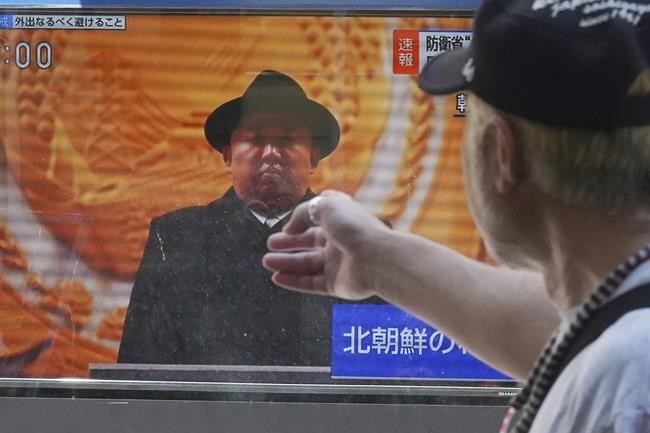SEOUL, South Korea (AP) — North Korea conducted its first intercontinental ballistic missile test in three months on Wednesday, two days after it threatened “shocking” consequences to protest what it called provocative U.S. reconnaissance activity near its territory.
Some experts say North Korea likely tested its developmental, road-mobile Hwasong-18 ICBM, a type of solid-fuel weapon that is harder to detect and intercept than the North's other liquid-fuel ICBMs. North Korean leader Kim Jong Un previously called the Hwasong-18 his most powerful nuclear weapon.
A long-range North Korean missile fired from its capital region around 10 a.m. flew about 1,000 kilometers (620 miles) at a maximum altitude of 6,000 kilometers (3,730 miles) before landing in waters between the Korean Peninsula and Japan, according to South Korean and Japanese assessments. They said the missile was launched on a high angle, in an apparent attempt to avoid neighboring countries.
South Korea's military called the launch “a grave provocation" and said the South Korean and U.S. authorities agreed to maintain robust, combined defense postures.
Chief Japanese Cabinet Secretary Hirokazu Matsuno also denounced North Korea over its repeated ballistic missile launches as “threats to the peace and safety of Japan, the region and international society.” He said that Japan protested to North Korea via embassies in Beijing.
The launch came as South Korean President Yoon Suk Yeol and Japanese Prime Minister Fumio Kishida were visiting Vilnius, Lithuania, to attend this week’s NATO summit. In an emergency security council meeting convened in Lithuania, Yoon told officials that North Korea must face consequences over its provocation. Matsuno said Kishida asked him to prepare for a security council meeting over the launch.
North Korea’s long-range missile program targets the mainland U.S, though it also has a variety of other shorter-range nuclear-capable missiles designed to hit South Korea and Japan, both key American allies in the region.
Since 2017, North Korea has performed a slew of intercontinental ballistic missile launches as part of its efforts to acquire nuclear-tipped weapons capable of striking major U.S. cities. Some experts say North Korea still has some technologies to master to possess functioning nuclear-armed ICBMs.
Before Wednesday’s launch, the North’s most recent long-range missile test happened in April, when it launched the Hwasong-18 ICBM for the first time. After that launch, Kim said the missile would enhance the North's counterattack capabilities in the face of U.S. military threats and ordered the expansion of his country's nuclear arsenal to "constantly strike extreme uneasiness and horror” in its rivals, according to state media.
Missiles with built-in solid propellants would be easier to move and hide, making it difficult for opponents to detect their launches in advance. All of North Korea's previous ICBM tests used liquid fuel.
Wednesday’s launch, the North’s first weapons firing in about a month, came after North Korea earlier this week released a series of statements accusing the United States of flying a military plane close to North Korea to spy on the North.
The U.S. and South Korea dismissed the North’s accusations and urged it to refrain from any acts or rhetoric that raised animosities.
In a statement Monday night, Kim Yo Jong, the influential sister of North Korean sister Kim Jong Un, warned the United States of “a shocking incident” as she claimed that the U.S. spy plane flew over the North’s eastern exclusive economic zone eight times earlier in the day. She claimed the North scrambled warplanes to chase away the U.S. plane.
In another fiery statement Tuesday, Kim Yo Jong said the U.S. military would experience “a very critical flight” if it continues its illicit, aerial spying activities. The North’s military separately threatened to shoot down U.S. spy planes.
North Korea has made numerous similar threats over alleged U.S. reconnaissance activities, but its latest statements came amid heightened animosities over North Korea’s barrage of missile tests earlier this year. Since the start of 2022, North Korea has test-fired about 100 missiles, many of them in response to military drills between the United States and South Korea. Some experts say Kim wants to use an expanded weapons arsenal to wrest greater concessions in eventual diplomacy with the U.S.
“Kim Yo Jong's bellicose statement against U.S. surveillance aircraft is part of a North Korean pattern of inflating external threats to rally domestic support and justify weapons tests,” said Leif-Eric Easley, a professor at Ewha University in Seoul. “Pyongyang also times its shows of force to disrupt what it perceives as diplomatic coordination against it, in this case, South Korea and Japan’s leaders meeting during the NATO summit.”
Before his departure to Lithuania, Yoon said in written responses to questions by The Associated Press that he would discuss North Korean nuclear threats with NATO leaders.
Kim Dong-yub, a professor at the University of North Korean Studies in Seoul, said Wednesday's launch appeared to be the North's second flight-test of the Hwasong-18 ICBM. He said the launch was likely made under the North's previously scheduled plans to hone Hwasong-18 technologies, rather than a direct response to the NATO gathering or the alleged U.S. spy plane flight.
The Hwasong-18 is among an array of high-tech weapons that Kim Jong Un has vowed to introduce to deal with what he called escalating U.S. military threats. Other weapons on his wish-list are an ICBM with multi-warheads, a hypersonic missile, a spy satellite and a nuclear-powered submarine. In late May, North Korea's launch of its first spy satellite ended in failure, with a rocket carrying it plunging to the ocean.
U.N. Security Council resolutions ban North Korea from engaging in any launches using ballistic technologies. But the U.S. and others have failed to toughen U.N. sanctions on North Korea over its numerous, recent ballistic missile tests because China and Russia, both permanent members of the U.N. Security Council, blocked such attempts.
___
Yamaguchi reported from Tokyo.
Hyung-jin Kim And Mari Yamaguchi, The Associated Press




